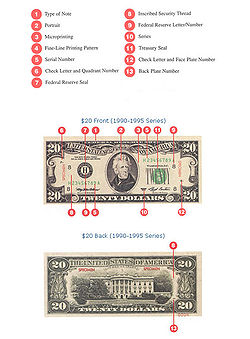Translations:AY Honors/Currency - Advanced/Answer Key/12/en

Traditionally, anti-counterfeiting measures involved including fine detail with raised intaglio printing on bills which would allow non-experts to easily spot forgeries. On coins, milled or reeded (marked with parallel grooves) edges are used to show that none of the valuable metal has been scraped off. This detects the shaving or clipping (paring off) of the rim of the coin. However, it does not detect sweating, or shaking coins in a bag and collecting the resulting dust. Since this technique removes a smaller amount, it is primarily used on the most valuable coins, such as gold. In early paper money in Colonial North America, one creative means of deterring counterfeiters was to print the impression of a leaf in the bill. Since the patterns found in a leaf were unique and complex, they were nearly impossible to reproduce.[1]
